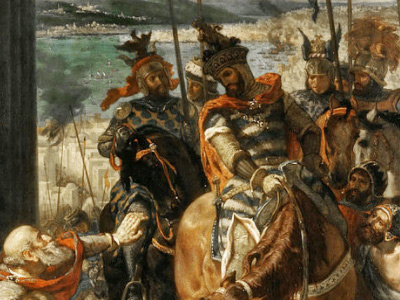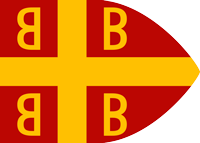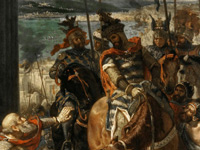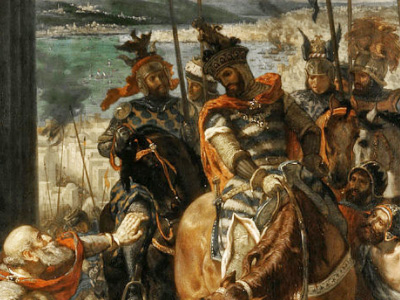Fourth Crusade (1202–04)

Diversion to Constantinople
The commercial rivalry between the Republic of Venice and the Byzantine Empire and the living memory of the Massacre of the Latins did much to exacerbate the feeling of animosity among the Venetians towards the Byzantines. According to the Chronicle of Novgorod Doge Enrico Dandolo had been blinded by the Byzantines during the 1171 expedition to Byzantium The Byzantine Empire, also referred to as the Eastern Roman Empire or Byzantium, was the continuation of the Roman Empire primarily in its eastern provinces during Late Antiquity and the Middle Ages, when its capital city was Constantinople. It survived the fragmentation and fall of the Western Roman Empire in the 5th century AD and continued to exist for an additional thousand years until the fall of Constantinople to the Ottoman Empire in 1453. and thus held personal enmity towards the Byzantines.
The Byzantine Empire, also referred to as the Eastern Roman Empire or Byzantium, was the continuation of the Roman Empire primarily in its eastern provinces during Late Antiquity and the Middle Ages, when its capital city was Constantinople. It survived the fragmentation and fall of the Western Roman Empire in the 5th century AD and continued to exist for an additional thousand years until the fall of Constantinople to the Ottoman Empire in 1453. and thus held personal enmity towards the Byzantines.
Boniface of Montferrat, meanwhile, had left the fleet before it sailed from Venice, to visit his cousin Philip of Swabia. The reasons for his visit are a matter of debate; he may have realized the Venetians' plans and left to avoid excommunication, or he may have wanted to meet with the Byzantine prince Alexios IV Angelos, Philip's brother-in-law and the son of the recently deposed Byzantine emperor Isaac II Angelos. Alexios IV had recently fled to Philip in 1201 but it is unknown whether or not Boniface knew he was at Philip's court. There, Alexios IV offered to pay the entire debt owed to the Venetians, give 200,000 silver marks to the crusaders, 10,000 Byzantine professional troops for the Crusade, the maintenance of 500 knights in the Holy Land, the service of the Byzantine navy to transport the Crusader Army to Egypt, and the placement of the Eastern Orthodox Church under the authority of the Pope, if they would sail to Byzantium and topple the reigning emperor Alexios III Angelos, brother of Isaac II. This tempting offer, for an enterprise that was short on funds, reached the leaders of the Crusade on 1 January 1203 as they wintered at Zara. Doge Dandolo was a fierce supporter of the plan; however, in his earlier capacity as an ambassador to Byzantium and someone who knew the finer details of how Byzantine politics worked, it is likely he knew the promises were false and there was no hope of any Byzantine emperor raising the money promised, let alone raising the troops and giving the church to the Holy See. Count Boniface agreed and Alexios IV returned with the Marquess to rejoin the fleet at Corfu after it had sailed from Zara. Most of the rest of the crusade's leaders, encouraged by bribes from Dandolo, eventually accepted the plan as well. However, there were dissenters. Led by Reynold of Montmirail, those who refused to take part in the scheme to attack Constantinople sailed on to Syria. The remaining fleet of 60 war galleys, 100 horse transports, and 50 large transports (the entire fleet was manned by 10,000 Venetian oarsmen and marines) sailed in late April 1203. In addition, 300 siege engines were brought along on board the fleet. Hearing of their decision, the Pope hedged and issued an order against any more attacks on Christians unless they were actively hindering the Crusader cause, but he did not condemn the scheme outright.
When the Fourth Crusade arrived at Constantinople on 23 June 1203, the city had a population of approximately 500,000 people, a garrison of 15,000 men (including 5,000 Varangians), and a fleet of 20 galleys. For both political and financial reasons, the permanent garrison of Constantinople had been limited to a relatively small force, made up of elite guard and other specialist units. At previous times in Byzantine history when the capital had come under direct threat, it had been possible to assemble reinforcements from frontier and provincial forces. On this occasion, the suddenness of the danger posed by the Fourth Crusade put the defenders at a serious disadvantage. The main objective of the crusaders was to place Alexios IV on the Byzantine throne so that they could receive the rich payments he had promised them. Conon of Bethune delivered this ultimatum to the Lombard envoy sent by the Emperor Alexios III Angelos, who was the pretender's uncle and had seized the throne from the pretender's father Isaac II. The citizens of Constantinople were not concerned with the cause of the deposed emperor and his exiled son; hereditary right of succession had never been adopted by the empire and a palace coup between brothers was not considered illegitimate in the way it would have been in the West. First the crusaders attacked and were repulsed from the cities of Chalcedon and Chrysopolis, suburbs of the great city. They won a cavalry skirmish in which they were outnumbered, defeating 500 Byzantines with just 80 Frankish knights.
Siege of July 1203
To take the city by force, the crusaders first needed to cross the Bosphorus. About 200 ships, horse transports, and galleys delivered the crusading army across the narrow strait, where Alexios III had lined up the Byzantine army in battle formation along the shore, north of the suburb of Galata. The Crusader knights charged straight out of the horse transports, and the Byzantine army fled south. The Crusaders followed and attacked the Tower of Galata, which held the northern end of the massive chain that blocked access to the Golden Horn. As they laid siege to the Tower, the Byzantines counterattacked with some initial success. The crusaders rallied, and the Byzantines retreated to the Tower, but the crusaders were able to follow the soldiers through the Gate and took the Tower. The Golden Horn now lay open to the Crusaders, and the Venetian fleet entered. The Crusaders sailed alongside Constantinople with 10 galleys to display the would-be Alexios IV, but from the walls of the city citizens taunted the puzzled crusaders, who had been led to believe that they would rise up to welcome the young pretender Alexios as a liberator.
On 11 July, the Crusaders took positions opposite the Palace of Blachernae on the northwest corner of the city. Their first attempts were repulsed, but on 17 July, with four divisions attacking the land walls while the Venetian fleet attacked the sea walls from the Golden Horn, the Venetians took a section of the wall of about 25 towers, while the Varangian guard held off the Crusaders on the land wall. The Varangians shifted to meet the new threat, and the Venetians retreated under the screen of fire. The fire destroyed about 120 acres (0.49 km2) of the city and left some 20,000 people homeless.
Alexios III finally took offensive action, leading 17 divisions from the St. Romanus Gate, vastly outnumbering the crusaders. Alexios III's army of about 8,500 men faced the Crusaders' seven divisions (about 3,500 men), but his courage failed, and the Byzantine army returned to the city without a fight. The unforced retreat and the effects of the fire greatly damaged morale, and the disgraced Alexios III abandoned his subjects, slipping out of the city and fleeing to Mosynopolis in Thrace. The Imperial officials quickly deposed their runaway emperor and restored Isaac II, robbing the crusaders of the pretext for attack. The crusaders were now in the quandary of having achieved their stated aim while being debarred from the actual objective, namely the reward that the younger Alexios had (unbeknownst to the Byzantines) promised them. The crusaders insisted that they would only recognize the authority of Isaac II if his son was raised to co-emperor, and on 1 August the latter was crowned as Alexios Angelos IV, co-emperor.
Further attacks on Constantinople
Alexios IV realised that his promises were hard to keep. Alexios III had managed to flee with 1,000 pounds of gold and some priceless jewels, leaving the imperial treasury short on funds. At that point the young emperor ordered the destruction and melting of valuable Byzantine and Roman icons in order to extract their gold and silver, but even then he could only raise 100,000 silver marks. In the eyes of all Greeks who knew of this decision, it was a shocking sign of desperation and weak leadership, which deserved to be punished by God. The Byzantine historian Nicetas Choniates characterized it as "the turning point towards the decline of the Roman state".
Forcing the populace to destroy their icons at the behest of an army of foreign schismatics did not endear Alexios IV to the citizens of Constantinople. In fear of his life, the co-emperor asked the crusaders to renew their contract for another six months, to end by April 1204. Alexios IV then led 6,000 men from the Crusader army against his rival Alexios III in Adrianople. During the co-emperor's absence in August, rioting broke out in the city and a number of Latin residents were killed. In retaliation armed Venetians and other crusaders entered the city from the Golden Horn and attacked a mosque (Constantinople at this time had a sizable Muslim population), which was defended by Muslim and Byzantine residents. In order to cover their retreat the Westerners instigated the "Great Fire", which burnt from 19 to 21 August, destroying a large part of Constantinople and leaving an estimated 100,000 homeless.
In January 1204, the blinded and incapacitated Isaac II died, probably of natural causes. Opposition to his son and co-emperor Alexios IV had grown during the preceding months of tension and spasmodic violence in and around Constantinople. The Byzantine Senate elected a young noble Nicolas Canabus as emperor, in what was to be one of the last known acts of this ancient institution. However he declined the appointment and sought church sanctuary.
A nobleman Alexios Doukas (nicknamed Mourtzouphlos) became the leader of the anti-crusader faction within the Byzantine leadership. While holding the court rank of protovestilarios, Doukas had led Byzantine forces during the initial clashes with the crusaders, winning respect from both military and populace. He was accordingly well-placed to move against the increasingly isolated Alexios IV, whom he overthrew, imprisoned, and had strangled in early February. Doukas then was crowned as Emperor Alexios V. He immediately moved to have the city fortifications strengthened and summoned additional forces to the city.
The crusaders and Venetians, incensed at the murder of their supposed patron, demanded that Mourtzouphlos honour the contract that Alexios IV had promised. When the Byzantine emperor refused, the Crusaders assaulted the city once again. On 8 April Alexios V's army put up a strong resistance, which did much to discourage the crusaders. The Byzantines hurled large projectiles onto the enemy siege engines, shattering many of them. Bad weather conditions were a serious hindrance to the crusaders. Fierce wind blew from the shore and prevented most of the ships from drawing close enough to the walls to launch an assault. Only five of the wall's towers were actually engaged and none of these could be secured; by mid-afternoon it was evident that the attack had failed.
The Latin clergy discussed the situation amongst themselves and settled upon the message they wished to spread through the demoralised army. They had to convince the men that the events of 9 April were not God's judgment on a sinful enterprise: the campaign, they argued, was righteous and with proper belief it would succeed. The concept of God testing the determination of the crusaders through temporary setbacks was a familiar means for the clergy to explain failure in the course of a campaign. The clergy's message was designed to reassure and encourage the Crusaders. Their argument that the attack on Constantinople was spiritual revolved around two themes. First, the Greeks were traitors and murderers since they had killed their rightful lord, Alexios IV. The churchmen used inflammatory language and claimed that "the Greeks were worse than the Jews", and they invoked the authority of God and the pope to take action.
Although Innocent III had again demanded that they not attack, the papal letter was suppressed by the clergy, and the crusaders prepared for their own attack, while the Venetians attacked from the sea. Alexios V's army stayed in the city to fight, along with the imperial bodyguard, the Varangians, but Alexios V himself fled during the night. An attempt was made to find a further replacement emperor from amongst the Byzantine nobility, but the situation had now become too chaotic for either of the two candidates who came forward to find sufficient support.
HISTORY

RESOURCES
This article uses material from the Wikipedia article "Fourth Crusade (1202–04)", which is released under the Creative Commons Attribution-Share-Alike License 3.0.
© Stories Preschool. All Rights Reserved.






